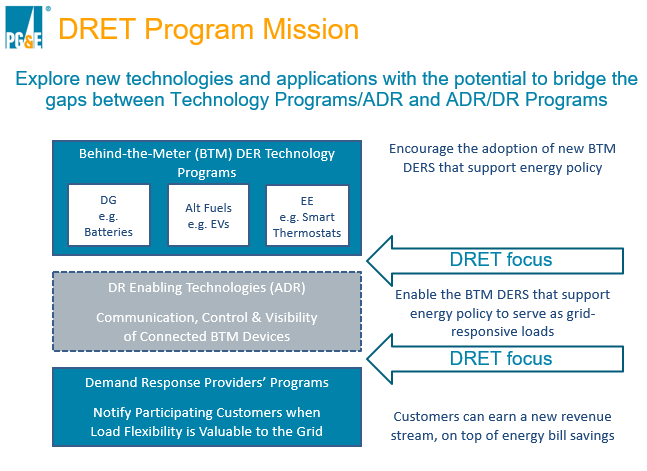About PG&E’s DRET Program
Pacific Gas and Electric’s (PG&E) Demand Response Emerging Technologies (DRET) program enables the assessment of new technologies and applications – such as “smart” devices behind customers’ meters, design tools, channels, or new program features that have the potential to enhance customers’ ability to better perform on DR, and facilitate DR integration into the CAISO markets. PG&E uses the DRET program to explore a potential gap in the delivery of DR for vendors of behind-the-meter (BTM) technology with the potential to provide DR resources but may not have the desire or capacity to change their business model to become an aggregator or DR provider themselves.
PG&E also uses DRET to study possible incentives to midstream and upstream market actors to adopt automated technologies that use standard open communication protocols, and to consider methodologies to determine deemed ADR incentives and how best to determine the incremental communication cost for different types of DR enabling technologies.
PG&E’s Demand Response Emerging Technologies (DRET) program have the following objectives:
- Explore new technologies and applications that have the potential to enable or enhance demand response (DR) and dynamic pricing (e.g., Peak Day Pricing, SmartRate) program capabilities and attributes.
- Assessments can include hardware, software, design tools, strategies, and services. Examples: advanced energy management control systems (EMCS), direct load controls, and advanced heating, ventilation, and air conditioning (HVAC) controls, enhancing and expanding Fast Track ADR SMB measures.
- Participate and co-sponsor demand response research through local, statewide and national studies, and technology pilots.
- Assist in developing new demand response and dynamic pricing technology.
- Advance the development of “smart” devices, storage, and other technologies that are seeing increasing customer adoption across sectors and have the potential to help customers better perform on DR programs.

